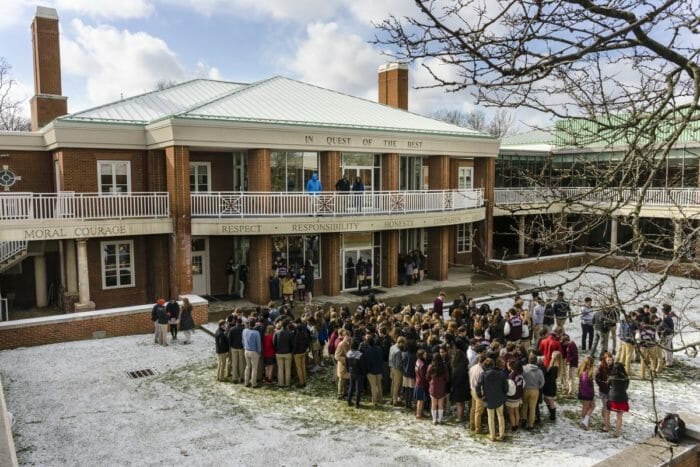Academy students gather in Senior Quad to participate in the National School Walkout. (Courtesy/Columbus Academy Twitter)
After the shooting at Columbine High School nearly two decades ago, the nation went into distress. Educators, students, and parents’ worries about the safety of schools escalated. Lawmakers debated for years on end, trying to find solutions to restore security. It was clear that change was needed.
School no longer felt like a safe place.
Many were hopeful. They were sure that after such a traumatic incident, federal and local governments would take all necessary steps so that tragedy would not strike again.
But while lawmakers and schools undertook measures limiting the possession of firearms, school shootings continued to occur across the nation at an alarming rate. In 2012, twenty-six students and teachers were killed in a shooting at Sandy Hook Elementary School. The unthinkable had once again occurred in what was once a safe haven for all.
2018 began with a record-setting number of school shootings in the month of January alone. The news of such an incident occurring became more and more agonizing.
Still, no one was anticipating the fatal shooting at Marjory Stoneman Douglas High School on February 14. We weren’t ready to hear about the devastating number of lives lost and to face the grief in the aftermath.
The problem lies in the loose grip our country holds on firearms. In less than an hour, an individual over the age of 18 can buy a gun. The purchaser undergoes a background check. But the standards are low.
In an act of defiance against the National Rifle Association, which has long had an impactful presence in Florida, Governor Rick Scott supported a substantial gun bill which addresses several necessary issues. The bill raises the legal age to buy a gun from 18 to 21 and instates a waiting period to ensure that a background check is completed or three days pass by (whichever is quicker) before an individual can walk away with a gun. It also bans bump stocks, the devices used to make rifles fire at a faster speed. Furthermore, the bill calls for the arming of school personnel, funds school security, and aims to expand mental health services.
While a step in the right direction, the bill introduces some controversial measures and leaves out solutions to significant issues. Even though a waiting period has been proposed to allow for enough time to process background checks, the checks themselves have not been strengthened: a critical part in the arms-buying process.
Disregarding the pleas of lawmakers and Marjory Stoneman Douglas students, the bill does not ban assault weapons, which are far more lethal than handguns. In fact, when comparing the United States with other major first-world nations, the number of gun deaths in America far exceed the rest combined. The difference? Stricter gun laws.
Japan, which had 6 gun deaths in 2014 compared to the over 33,000 in the United States, was one of the first nations to implement gun laws and possesses some of the strictest regulations, even to this day. The process of purchasing a gun is lengthy, consisting of attending an all-day class, passing a shooting range test and a written exam. In addition, handguns and semi-automatic weapons are banned, and extensive background checks and mental health examinations must take place. The location in which a purchased weapon is stored must be made known to the police, and venue is subject to yearly inspections.
While the new gun bill in Florida is progress, its impact pales in comparison to the marches and walkouts organized in response to the horrific Marjory Stoneman Douglas shooting. Because the outrage following this incident is different. Unlike many tragedies in the past, the anger and frustration surrounding this tragedy is still steamrolling its way into headlines 60 days later.
Though the longevity of this movement is unprecedented, it was only a matter of time before an act of gun violence harmed a community ready to swing back. Six survivors of the Stoneman Douglas shooting created “Never Again,” a gun-control organization that has blossomed through support from students everywhere. On March 14, a National School Walkout was organized, and students from around the country left their typical school activities for 17 minutes: one for each victim. Then, led by the Stoneman Douglas students, over 2 million people participated in the March for Our Lives at the nation’s capital on March 24. Over 800 sibling marches took place simultaneously, as people took to the streets to honor the Parkland students and to protest gun violence.
For students who are not yet eligible, as many of us are at Academy, our power lies in our voices and at our attendance at these walkouts and marches. When upper school students rallied behind the same cause students across the United States were fighting for during the March 14 walkout, we were taking a moment to engage in meaningful discussion, to write letters to those at Stoneman Douglas, to make ourselves heard.
As the 19th anniversary of the Columbine tragedy approaches, exactly how much progress have we made?
It has taken far too long, but recent actions from lawmakers and students alike indicate that we are finally accelerating towards major progress.
As the future of this nation, it is our duty to capitalize on the momentum.








